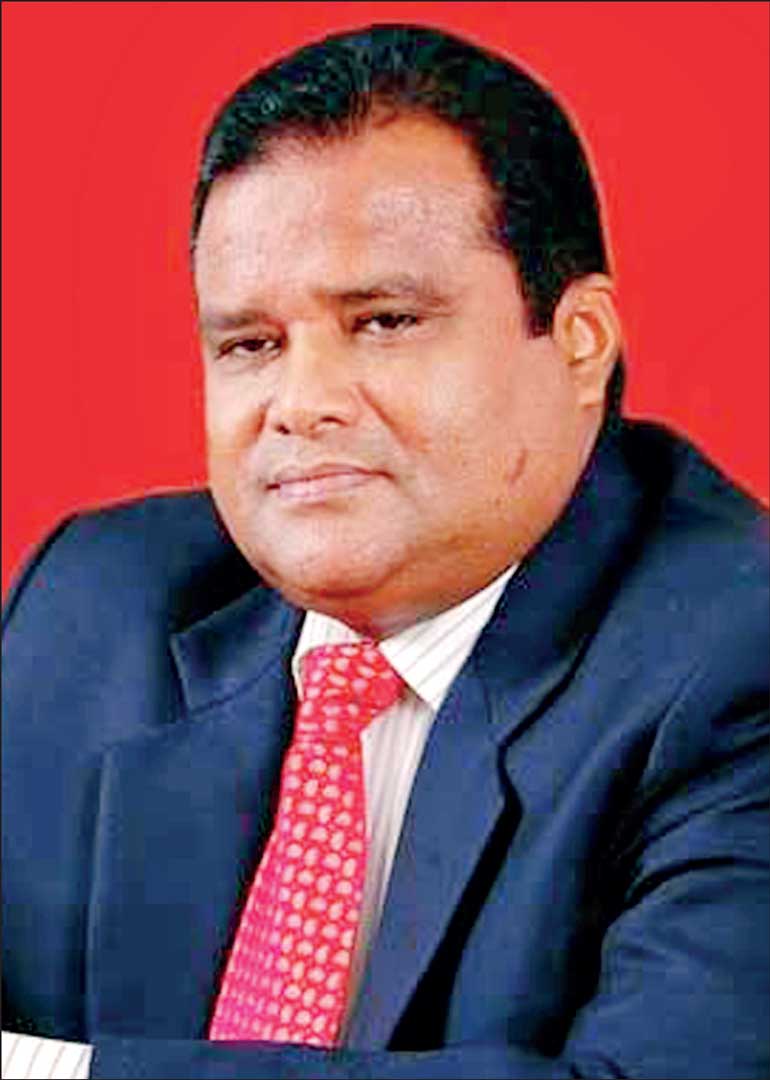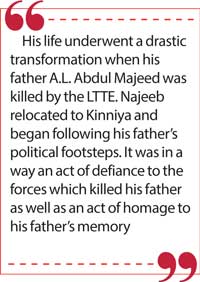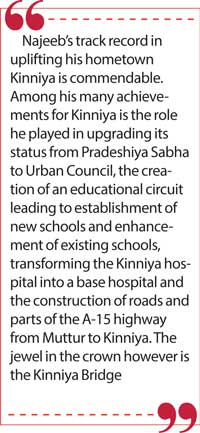Saturday Apr 19, 2025
Saturday Apr 19, 2025
Friday, 29 December 2023 00:50 - - {{hitsCtrl.values.hits}}

Najeeb Abdul Majeed
 Mohammed Najeeb Abdul Majeed created history 11 years ago when he was sworn in as the Chief Minister of the Eastern Province on 18 September 2012 by the then President Mahinda Rajapaksa. Najeeb Abdul Majeed known popularly as Najeeb achieved two significant “firsts” then. Not only did he become the first Muslim chief minister of the Eastern Province but more importantly Najeeb also gained the honour of being Sri Lanka’s first ever Muslim chief minister.
Mohammed Najeeb Abdul Majeed created history 11 years ago when he was sworn in as the Chief Minister of the Eastern Province on 18 September 2012 by the then President Mahinda Rajapaksa. Najeeb Abdul Majeed known popularly as Najeeb achieved two significant “firsts” then. Not only did he become the first Muslim chief minister of the Eastern Province but more importantly Najeeb also gained the honour of being Sri Lanka’s first ever Muslim chief minister.
The affable Najeeb who recorded these two remarkable firsts passed away due to illness last week at a private hospital in Colombo on 22 December 2023. The funeral took place at night on the same day in Najeeb’s hometown of Kinniya in the Trincomalee district. 66-year-old Najeeb Abdul Majeed is survived by his wife and five children. This article focuses on Najeeb’s eventful life with special emphasis on the circumstances that led to his elevation as Lanka’s first Muslim chief minister.
Trincomalee district
Let me commence with a brief description about Muslim political history in the Trincomalee district. After Independence, Trincomalee district had two single-member electorates from 1947 to 1960. One was the Tamil majority Trincomalee Constituency and the other, the Muslim majority Mutur pronounced as “Moodhoor” in Tamil. Although the electorate was named Mutur which had a substantial mixed population of Muslims and Tamils, the area where Muslims were largely concentrated was Kinniya, the hometown of Najeeb. It is about 20 km away from Trinco town and about 240 km from Colombo. Kinniya with over 97% Muslims has been the determining factor in the Muslim politics of Trincomalee.
In 1960 Mutur was made a double-member constituency to enable a Tamil also to be elected along with a Muslim. Trincomalee remained a single-member electorate. This arrangement was in force till 1977. It was during this time that Najeeb’s father Abdul Latheef Abdul Majeed was elected to Parliament from Mutur. He won in July 1960, March 1965 and May 1970 and served as MP continuously for 17 years. A.L. Abdul Majeed was known popularly as “Mutur Majeed”.
In 1977-Trincomalee district was carved into three single-member constituencies. While Trincomalee and Mutur were Tamil and Muslim majority electorates respectively, the newly-created Seruwila was a Sinhala majority electorate. After the electoral reforms under President J.R. Jayewardene where the “first past the post winner” system was converted into a scheme of proportional representation, the entire Trincomalee district became one electoral district. The electorates of Trincomalee, Muttur and Seruwila became electoral divisions.
Dynastic politics is a common feature in Sri Lankan politics regardless of ethnicity. In the Trincomalee district two Muslim families have dominated politics for decades. Both families hail from Kinniya.
M.E.H. Mohammed Ali
The first to make his mark was Mohammed Ehuthar Hadjiar Mohammed Ali who won in Mutur as an Independent in 1952 defeating the incumbent A.R.M. Abubucker of the UNP. In 1956 M.E.H. Mohammed Ali contested again as an Independent backed by the Ilankai Thamil Arasu Katchi (ITAK) and won with a handsome majority.
After Mutur was made a double-member constituency in 1960 M.E.H. Mohammed Ali contested in March 60 as an Independent and was elected as second MP. The first was T. Ahamparam of the ITAK or Federal party. Mohammed Ali contested on the UNP ticket and lost in the 1960 July elections. In 1962 there was a by-election in Mutur after the demise of Ahamparam. Mohammed Ali joined the ITAK and contested under the house symbol and won. He again contested on the ITAK ticket in March 1965 and was elected as the only Muslim MP in that party. He crossed over to the UNP in 1969 and contested in 1970. Mohammed Ali lost.
Later in 1977 Mohammed Ali’s brother Mohammed Ehuthar Hadjiar Maharoof contested on behalf of the UNP in Mutur and won. M.E.H. Maharoof won again in 1989 and 1994 also. He was killed by the LTTE in 1997. The family banner was raised again in the 2012 Eastern Provincial poll when Imran Maharoof was elected from the Trincomalee district. Imran, the son of M.E.H. Maharoof was elected to Parliament in 2015 and 2020. A cousin of Imran, M.A.M. Maharoof known as “Sinna” Maharoof was also an MP.
A.L. Abdul Majeed
 The other prominent Muslim political family from Kinniya is that of Najeeb’s. His father Abdul Latheef Abdul Majeed first contested Mutur in March 1960 as an Independent and lost. In a bold move he joined the SLFP and contested the July 1960 polls under the hand symbol. Thereafter Abdul Majeed won the 1965 and 1970 elections too. He lost in 1977 in a three-corner fight among UNP’s Maharoof, Mackeen Master of the Muslim United Front and himself on the SLFP ticket.
The other prominent Muslim political family from Kinniya is that of Najeeb’s. His father Abdul Latheef Abdul Majeed first contested Mutur in March 1960 as an Independent and lost. In a bold move he joined the SLFP and contested the July 1960 polls under the hand symbol. Thereafter Abdul Majeed won the 1965 and 1970 elections too. He lost in 1977 in a three-corner fight among UNP’s Maharoof, Mackeen Master of the Muslim United Front and himself on the SLFP ticket.
After A.L. Abdul Majeed’s death in 1987 at the hands of the Tigers, his son Najeeb entered politics. Later Imran the son of M.E.H. Maharoof also killed by the LTTE in 1997 entered politics through the UNP. Thus another generation from the two prominent Muslim political families from Kinniya were in the Trincomalee political ring.
1 January 1957
Najeeb A. Majeed was born on 1 January 1957. He had his early education at Kinniya Central College. Thereafter he joined Zahira College in Gampola. At school Najib excelled in track and field and was once the champion in his age group at a zonal athletic meet. He also played rugger in the positions of Prop and Lock forward. After Gampola Zahira, Najeeb went to Jaffna and studied at the St. John’s Academy. Some of his Tamil classmates from Jaffna still remember him with affection.
Later Najeeb moved to Colombo and became a junior executive at a shipping firm. He also began pursuing legal studies as an external student. His life underwent a drastic transformation when his father A.L. Abdul Majeed was killed by the LTTE. Najeeb relocated to Kinniya and began following his father’s political footsteps. It was in a way an act of defiance to the forces which killed his father as well as an act of homage to his father’s memory.
Najeeb had his electoral baptism in 1989 when he contested Parliamentary Elections from his father’s party the SLFP. He lost. In 1993 he contested in the Kinniya Pradeshiya Sabha hustings and was elected chairman. In 1994 Najeeb faced Parliamentary Elections again.
Sri Lanka Muslim Congress
This was the time when the Sri Lanka Muslim Congress Leader M.H.M. Ashraff had entered into an electoral pact with the People’s Alliance (PA) leader Chandrika Kumaratunga. Under this accord the PA was not able to field Muslim candidates of its own in the North and East. The SLFP to which Najeeb belonged was the chief constituent of the PA. He was however the most formidable Muslim candidate who could compete with the UNP’s M.E.H. Maharoof in Trinco district. So was found, a way out.
Najeeb Abdul Majeed contested the polls in 1994 on the Sri Lanka Muslim Congress ticket by joining it. He was elected on the ‘Tree’ symbol with 21,590 preferences and entered Parliament for the first time. His Muslim political rival M.E.H. Maharoof won from the UNP with 17,043 preference votes.
When Parliamentary polls were held in 2000 the SLMC was once again with the PA although Ashraff was no more. Najeeb contested in the Trincomalee district and won again with 18,173 preferences. Najeeb was appointed Deputy Minister of Posts and Telecommunications. Subsequently there was a split in the SLMC leading to rival factions being led by Ashraff’s disciple Rauff Hakeem and Ashraff’s widow Ferial Ashraff.
In 2001 the SLMC contested along with the UNP. Najeeb who had remained loyal to Rauff Hakeem in the SLMC split up with Ferial Ashraff, contested as part of the tie UNP. He failed to get elected.
The 2004 Parliamentary elections saw Najeeb bouncing back into Parliament with a rousing victory. He got 26,948 preferential votes. Soon afterwards there was a split in the Muslim Congress where some MPs revolted against Rauff Hakeem’s leadership. Najeeb was one of the rebel MPs. Another Muslim party was formed by Rishad Bathiutheen.
All Ceylon Makkal Congress
Najeeb joined Bathiutheen’s party called then as the All Ceylon Muslim Congress. It later became the All Ceylon Makkal Congress. In 2007 Najeeb returned to the political roots of his family by rejoining the SLFP which was the premier constituent of the UPFA.
Najeeb was Deputy Minister of Local Government and Provincial Councils in the 2004-2010 Parliament. In 2007 he was made non-cabinet minister of Cooperatives by President Mahinda Rajapaksa.
Najeeb contested Parliamentary polls in 2010 and lost. Thereafter he functioned as the Presidential coordinator for the Trincomalee district and SLFP organiser for the Mutur electoral division. When Provincial Council polls were scheduled to be held in September 2012, Najeeb was among the few ex-MPs who entered the fray. He was elected with 11,726 preference votes.
Eastern Provincial Council
 The 2012 Eastern Provincial poll saw a “hung” council with the UPFA-NFF and TNA-UNP combines having 15 seats each. This made the Muslim Congress with seven seats assume the role of Kingmaker in a council of 37. Initially President Rajapaksa appointed a high level ministerial committee to work out political arrangements to form a majority, determine the choice of a new Eastern Provincial Chief Minister and finalise composition of the provincial ministerial board.
The 2012 Eastern Provincial poll saw a “hung” council with the UPFA-NFF and TNA-UNP combines having 15 seats each. This made the Muslim Congress with seven seats assume the role of Kingmaker in a council of 37. Initially President Rajapaksa appointed a high level ministerial committee to work out political arrangements to form a majority, determine the choice of a new Eastern Provincial Chief Minister and finalise composition of the provincial ministerial board.
The four-member team of then cabinet ministers Basil Rajapaksa, Anura Priyadarshana Yapa, Susil Premajayantha and Dullas Alahapperuma engaged in detailed discussions with SLMC leader Rauf Hakeem, ACMC leader Rishad Bathiutheen, Tamil Makkal Viduthalap Puligal (TMVP) leader Sivanesathurai Chandrakanthan alias Pillaiyan and National Congress leader A.H.M. Athaullah. The ministers also consulted Sri Lanka Freedom Party (SLFP) stalwarts of the east.
“Pillaiyan”
When the discussions began the former Chief Minister of the Eastern Provincial Council “Pillaiyan” was strongly tipped to be re-appointed again as Chief Minister on account of an assurance reportedly given by Mahinda Rajapaksa to him prior to the Eastern Council being dissolved one year ahead of its scheduled term of office. The Government was apparently thinking of retaining Pillaiyan as Chief Minister until another Tamil became Chief Minister in the Northern Province. The Government intended replacing Pillaiyan with a Muslim Eastern Chief Minister after elections were held to the Northern Provincial Council and a Tamil Chief Minister assumed office.
These plans however underwent a drastic change after Muslim leaders of all political hues insisted that a Muslim should be made Eastern Chief Minister due to two reasons.
Firstly they pointed out that a Tamil had been appointed chief minister previously and so it was nothing but fair that a Muslim should be made chief minister this time.
Secondly they stated that only one Tamil had been elected from the UPFA this time whereas seven Muslims had won on the betel symbol. The ministerial panel was reminded that although there were more Muslims elected on the betel symbol in 2008 they had consented to the Government’s decision of appointing a Tamil then. Now it was the turn of the Muslims.
Independently the SLMC also pressed for a Muslim chief minister. The SLMC emphasised that in a situation where the Tamil National Alliance (TNA) was offering the chief ministership to a Muslim, if the Muslim Congress joined forces with the Tamil party, it would be impossible to convince its eastern supporters to accept a situation where the SLMC agrees to a Tamil chief minister.
The ministerial panel agreed with this position and informed “Pillaiyan” of the change of plan. He was told that he could not be chief minister again but could be compensated with other posts
Ameer Ali/Nazeer Ahamed
When it came to the question of a Muslim chief minister the UPFA constituent parties namely Bathiutheen’s ACMC and Athaullah’s NC forged a common front. Both parties wanted M.S.S. Ameer Ali of Oddamavaddi to be the chief minister. Ameer Ali was elected to the Council from the Batticaloa district. He was from the ACMC but enjoyed close rapport with Athaullah.
The SLMC for its part pressed its case for a chief minister from their ranks. Rauff Hakeem wanted the then SLMC deputy leader Zainulabdeen Nazeer Ahamed to be the chief minister. Nazeer Ahamed hailing from Eravur had won from Batticaloa district.
SLFP stalwarts from the East including its Sinhala members insisted that the post should go to a SLFP member. They pointed out that allowing someone from a party other than the SLFP to become the first Muslim chief minister would greatly disappoint party loyalists and set a bad precedent.
If the chief minister was to be a Muslim and that too from the SLFP there was only one choice. It was Mohamed Najeeb Abdul Majeed from Kinniya. Najeeb A. Majeed was the only Muslim elected on the UPFA ticket from the SLFP. Three Muslims elected on the UPFA from the Amparai district were from Athaullah’s National Congress. Three Muslims elected on the betel symbol from the Batticaloa district were from Bathiudeen’s All Ceylon Makkal Congress. Also, the only Muslim elected from the UPFA in Trincomalee was Najeeb.
President Rajapaksa’s intervention
Under these circumstances the Ministerial panel recommended to President Rajapaksa that Najeeb be made chief minister. Despite this both the SLMC and ACMC-NC wanted their man made chief minister of the east. Their nominee being appointed as the first Muslim chief minister was a matter of prestige for these parties. The three-corner tussle ended finally with President Rajapaksa’s direct intervention.
President Rajapaksa held a high level meeting of ministers at “Temple Trees” on 17 September 2012. President Rajapaksa after discussing matters in detail decided upon a formula to appoint the new chief minister for the Eastern Province and also allocate provincial ministry and chairman/deputy chairman posts. The Sri Lanka Freedom Party (SLFP)’s solitary Muslim Provincial Councillor Najeeb Abdul Majeed was formally endorsed as chief minister elect on 17 September 2012.
Sworn in at “Temple Trees”
On the following day Mohammed Najeeb Abdul Majeed was sworn in before President Rajapaksa at “Temple Trees”. In a statement issued by him after assuming office on 18 September 2012, the new chief minister pledged to serve the people of the Eastern Province regardless of race and religion. Pointing out that all three main ethnicities were living together in the Province the Eastern Chief Minister promised to preserve and foster goodwill, unity and amity among all three. Najeeb also said he would focus on developing the Eastern Province. He also said there were some problems and that he would try and resolve them through negotiations and discussions.
After serving as Eastern Chief Minister for two and a half years, Najeeb stepped down in 2015. Nazeer Ahamed became chief minister. Najeeb himself contested the 2015 Parliamentary poll and failed to get elected. He tried to contest the 2020 elections on the SLFP ticket but the nomination list was rejected by the Elections Commission. Thus Najeeb was out of Parliament again. Meanwhile his health began to deteriorate and finally the end came after a prolonged period of illness.
Uplifting Kinniya
Najeeb’s track record in uplifting his hometown Kinniya is commendable. Among his many achievements for Kinniya is the role he played in upgrading its status from Pradeshiya Sabha to Urban Council, the creation of an educational circuit leading to establishment of new schools and enhancement of existing schools, transforming the Kinniya hospital into a base hospital and the construction of roads and parts of the A-15 highway from Muttur to Kinniya. The jewel in the crown however is the Kinniya Bridge.
The Kinniya Bridge is 10 m wide and 396 m (1,299 ft.) long. It has replaced the old ferry service on the Kinniya lagoon which is surrounded by the Koddiyar and Thambalagamam bay. The bridge built with Saudi Arabian assistance is part of the A-15 highway. It was officially declared open on 20 October 2009 by President Mahinda Rajapaksa. The Kinniya Bridge is the longest bridge in Sri Lanka.
(The writer can be reached at [email protected].)
Discover Kapruka, the leading online shopping platform in Sri Lanka, where you can conveniently send Gifts and Flowers to your loved ones for any event including Valentine ’s Day. Explore a wide range of popular Shopping Categories on Kapruka, including Toys, Groceries, Electronics, Birthday Cakes, Fruits, Chocolates, Flower Bouquets, Clothing, Watches, Lingerie, Gift Sets and Jewellery. Also if you’re interested in selling with Kapruka, Partner Central by Kapruka is the best solution to start with. Moreover, through Kapruka Global Shop, you can also enjoy the convenience of purchasing products from renowned platforms like Amazon and eBay and have them delivered to Sri Lanka.
Discover Kapruka, the leading online shopping platform in Sri Lanka, where you can conveniently send Gifts and Flowers to your loved ones for any event including Valentine ’s Day. Explore a wide range of popular Shopping Categories on Kapruka, including Toys, Groceries, Electronics, Birthday Cakes, Fruits, Chocolates, Flower Bouquets, Clothing, Watches, Lingerie, Gift Sets and Jewellery. Also if you’re interested in selling with Kapruka, Partner Central by Kapruka is the best solution to start with. Moreover, through Kapruka Global Shop, you can also enjoy the convenience of purchasing products from renowned platforms like Amazon and eBay and have them delivered to Sri Lanka.